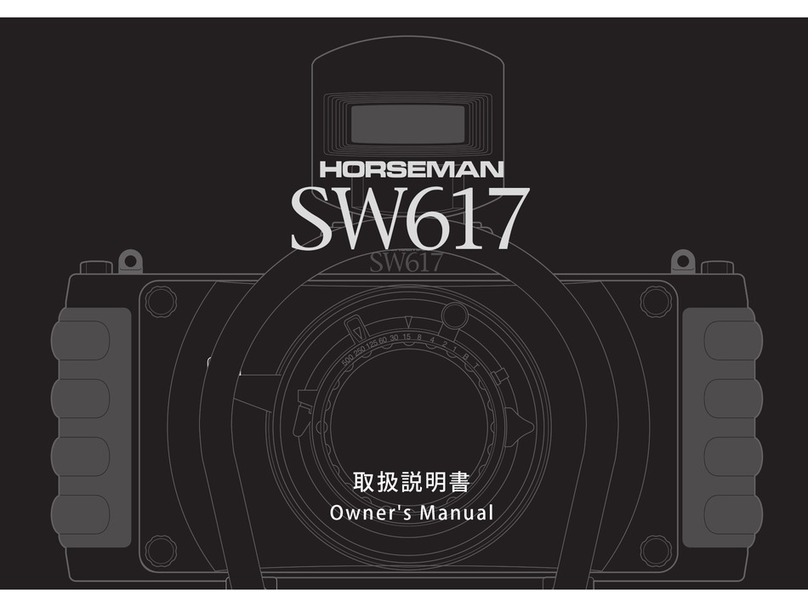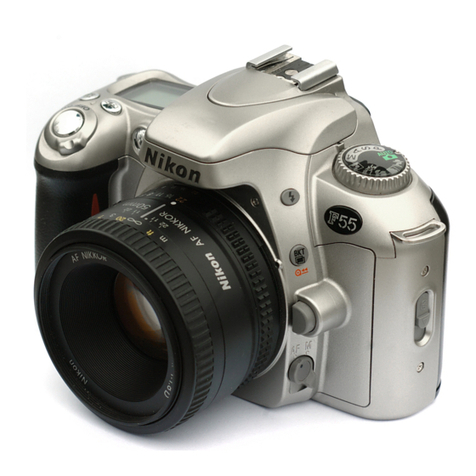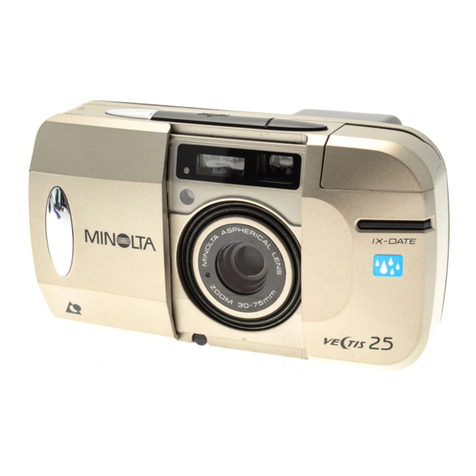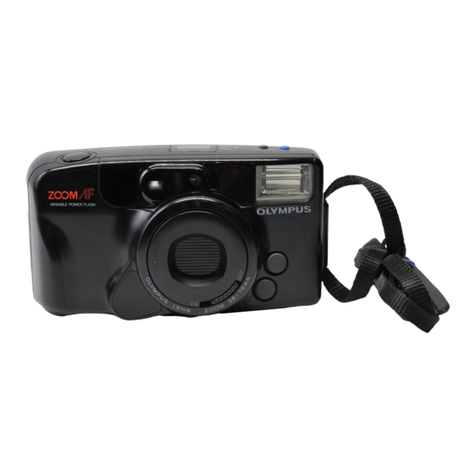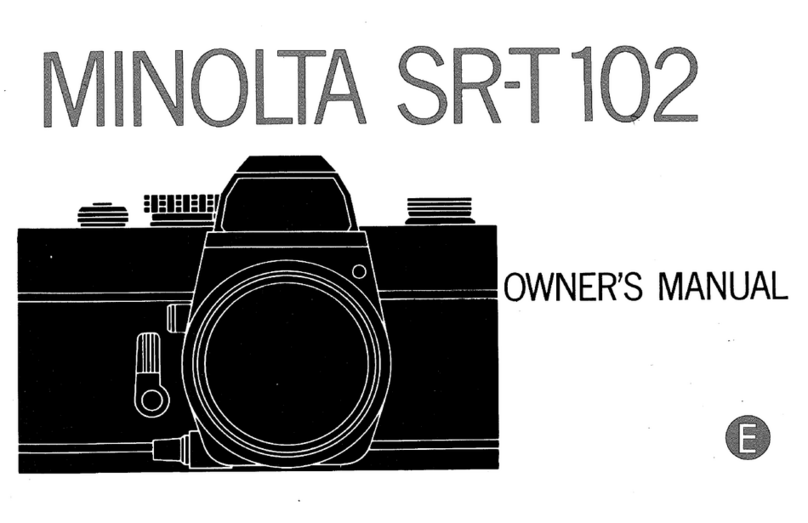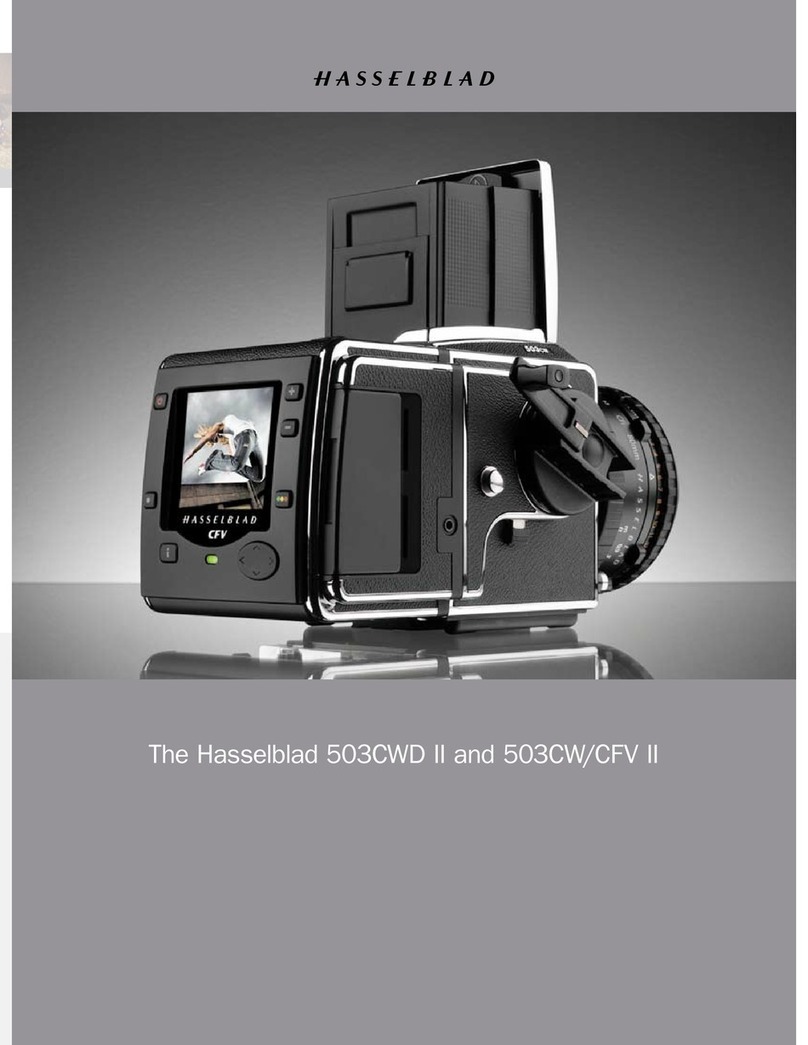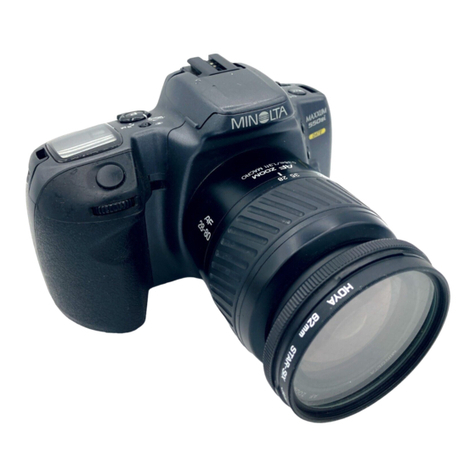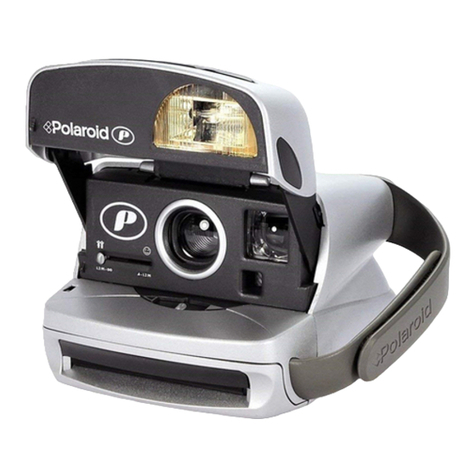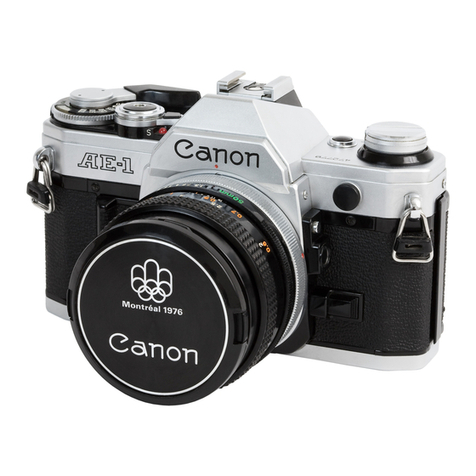ROLLEIFLEX SL66 User manual

Rolleiflex SL 66 User Manual
Revised and updated by RolleiClub
©2002 RolleiClub.com

Lens mount locating mark
Lens carrier panel and tilt
Magazine back door release catch
Waist level nder
Focusing hood release button (each side)
Carrying strap connector (each side)
Depth of eld scale
Distance scale (meter or feet)
Focal length selector for distance scale
Focusing knob
Accessory shoe (not a hot shoe)
Rollei type ash plug release
Flash sockets X & FP
Locking knob for lens tilt function
Release lever for lens tilt function
Scales for extension, image scale, lens
tilt and exposure correction
Diaphragm stop down control
Dual front bayonet ring for lters, retro
mounting and lens hood
Rolleiflex SL 66 Parts
2
SL66.com

Storage compartment of magazine slide
Magazine slide handle with window to insert
lm box top for lm type indication
Change-over control for 12 or 24 exposures
Counter for 12 or 24 exposures
Magazine winding knob for lm advance
Shutter speed setting dial
Film transport disengagement for multiple
exposures
Shutter tensing and lm transport crank
Mirror pre-release
Magazine lock
Magazine winding knob release button (not on
early models)
Magazine loading indicator
Release button, lockable, w. cable release
thread
Dove tail tting for tripod and hand grip quick
coupling
Lens change release button
Tripod thread
Parts
Rolleiflex SL 66
3
SL66.com

Rolleiflex SL 66
We might assume that as an owner of the
professional SL66 camera you will know all
about the basic technicalities of photography.
So, we have kept this revised manual concise.
Taking pictures, extended functions of the
camera, and the interchangeable components
are covered in three chapters.
Tables and reference charts show all
important data at a glance: focal length and
camera extension at various magnifications.
We are sure that you will be successful with
your Rolleiflex SL66, as this system has
proven its superior quality and durability for
over 30 years.
If you have any questions, please contact the
RolleiClub at info@rolleiclub.com
5 The Most Important Rule
Taking Pictures
6 Loading the Magazine
7 Checking the Readiness to Shoot
8 Shooting
9 Film Transport & Shutter Tension
9 Unloading the Magazine
Extended Functions
10 Distance Scale
11 Scale of Reproduction
11 Depth of Field
12 Extended Depth (see also Page 26)
12 Mirror pre-release
13 Multiple Exposures
13 Flash Connectors
14 Filters & Lens Hoods
14 Tripod Coupling
15 Neck Strap
15 Film Type Reminder
Interchangeable Components
16 Lens Change & Retro Mounting
16 Focusing Hood Change
17 Magnifier Eye Piece Change
17 Focusing Screen Change
18 Magazine Change
19 Loading a Spare Magazine
Tables & Data Summaries
20 Interchangeable Lenses
21 Scales of Reproduction. Lens Extensions
& Exposure Corrections
22 Normal or Reversed Lens Mounting?
23 Infra-red Focusing Correction
24 Focusing Ranges Summed up
26 Scheimpflug Tilt Indicator Instructions
30 Care of Your Camera
30 Rolleiflex SL66 Accessories
31 Trouble Shooting
Contents
Rolleiflex SL 66:
The Camera System for Experts
4
SL66.com

The Most Important Rule Taking Pictures
Before you load or unload a film
Before you remove or fit a magazine
Before you press the release button -
Always check that the crank is unfolded and
blocked.
For this purpose, swing the crank fully clock
wise as far as it will go (1) - about 270
degrees -, and back again (2).
This tensions the shutter and advances the
film. It also sets and activates automatic
safety interlocks to prevent waste of film dur-
ing film or magazine changing.
Accidental double exposures, blank frames
and overlapping pictures are not possible this
way.
Once the crank is locked, you are sure that
the camera is ready for correct operation.
For taking pictures, you will find all neces-
sary basic information on the next four
pages:
From loading a new film to unloading the
exposed roll.
You can also practice the individual steps
on your camera without a film. To do this,
the camera must be in its standard shooting
mode - with the magazine attached and the
dark slide stored in its compartment in the
back of the magazine door.
5
SL66.com

Loading the Magazine
The procedure for loading a magazine is the
same whether the magazine is attached or off
the camera.
When there is only a single magazine in
use, there is no need to remove it from the
camera to load or unload film. In this case,
the dark slide can remain permanently in its
storage compartment in the back door of the
magazine.
Basic Rule: Unfold the crank (1) and turn
it clock wise 270 degrees and back to its
original position until it locks.
Open the magazine: Unlock the back (2)
and swing open the back door (3).
This also causes the magazine winding knob
(4) to pop out; the exposure counter (5) is
reset to # 1.
Take the film insert by the central bar (6)
and swing it out of the magazine.
Setting the magazine for 12/24 exposures:
Switch over the film length selector lever (7).
The film counter window (5) shows 12 or 24 to
indicate the selected setting for 120 or 220 type
roll film. On magazines for 4,5x6cm exposures,
it shows 16 or 32.
You can change this setting even after the film
is loaded and the magazine is closed, as long as
the film counter still shows # 1.
Loading a roll film: Swing open the lower
spool holder (8). Remove the seal of the film
and fit the new spool (9) between the right-side
fixed and the hinged shaft pins on the left side.
The black inside surface of the backing paper
(10) must face outwards as shown.
Run the backing paper around the back of the
film insert and thread it into the slot (11) of the
empty spool in the upper part of the film insert.
Tighten the paper leader by one or two turns of
the gear wheel (12). There is no need to watch
for the printed arrows on the backing paper,
since the camera senses the beginning of the
film automatically.
6
SL66.com

Loading the Magazine
Take the loaded film insert by its center bar
and slide it into the magazine with the upper
take-up spool first (13), so that the gearing
wheels on the insert and inside the magazine
engage.
Check the film advance by a short clock wise
turn of the winding knob (14). Then, swing
the magazine back door up and push it
closed (15). Check that it is properly locked.
Advancing the film to exposure # 1:
Turn the magazine winding knob (14) until it
automatically locks when the camera senses
the beginning of the film emulsion. Then
push the winding button into the magazine
(16). The camera is now set and ready for
the first exposure. For subsequent exposures,
the crank will take care of transporting the
film.
The loading indicator (18) in the bottom of
the magazine reads like an exclamation
mark ! when the magazine is loaded with a
film. When the magazine is empty, the dot
and the stripe do lot align.
To unload a film before it is fully
exposed, press button (17) on the bottom
of the magazine with a pen or similar. The
magazine knob pops out and you can pro-
ceed as indicated on page 9.
If in doubt, it is possible to check readiness to
shoot by pressing the crank release button (18)
and pushing the crank clock wise at the same
time without wasting a frame.
If the crank is locked, the camera is ready. If the
crank is not locked, start moving it clock wise,
let go of the lever (18) and complete the crank-
ing movement fully back to its original position.
If you notice that you forgot to wind the crank
only when pressure on the release has no effect,
the same procedure still avoids wasting a film
frame.
You can loose the first picture - and in fact wind
the film through completely - only if the crank
movement was not completed and the crank is
not pointing forward.
While this in no way harms the camera, you can
avoid it by making a habit of always check-
ing that the crank is locked before loading
the camera.
7
Checking Readiness
SL66.com

Taking Pictures
Remove the lens cap (turning it counter clock
wise with old style caps, or pressing the but-
tons on new style caps).
Open the focusing hood (1). To raise the
magnifier press the silver key (2). To close
the focusing hood, press down the magni-
fier frame between the magnifier and the
upper front of the focusing hood (3) until it
engages. Then, push the side panels inside.
1. The Shutter Speed
Turn the shutter time knob (4) to select
the desired shutter time. The figures from
1 through 1000 represent fractions of a
second, B is a setting for unlimited time
exposures. Intermediate settings are not
allowed.
Shutter speeds for flash: see page 13.
Exposure value correction: pages 21 & 25.
2. The Aperture
Turn the aperture ring (5) to the desired set-
ting. It engages at full and half stops (except
leaf shutter lenses: 1/3 stop). All lenses
except the 500mm and 1000mm lenses
have a fully automatic iris diaphragm. The
lens remains fully opened until the actual
exposure.
3. Focusing
Turn the focusing knob (6) until the picture ap-
pears sharp on the focusing screen (7).
With lenses of longer focal lengths and when
using extreme Scheimpflug depth tilt, the mirror
might cut off a strip at the top of the screen im-
age. This does not affect the picture taken: the
exposure will always cover the entire negative.
Distance Scale: page 10
Depth of Field: page 11
Scheimpflug Depth Tilt: page 12
4. Releasing
Unlock the release button by turning it coun-
ter clock wise (red dot points sideways when
unlocked, upwards when locked).
Time Exposures at B Setting:
Press down the release button for the duration
of the required exposure. For longer exposures,
the release button can be locked when pressed
down by turning the locking collar clock wise.
The shutter will close once the release is un-
locked or no longer pushed in.
The release button incorporates a cable re-
lease thread for standard cable releases.
8
SL66.com

Film Transport &
Shutter Tension
After every exposure, unfold the crank and
turn it clock wise 270 degrees and back to its
original position (9).
The forward swing tensions the shutter, while
the return swing advances the film. The cam-
era is then ready for the next exposure.
During a shooting session, the crank may
remain unfolded for immediate operation.
After the last exposure on a roll of film, the
magazine knob pops out when you turn the
crank - an audible and visible sign that the film
is finished.
First complete any started crank movement
(10), fully forward and all the way back. Then
wind the magazine knob (11) clock wise until
the remainder of the film backing paper is
wound up completely and the winder knob turns
freely without resistance.
Open the magazine (12) and remove the film
insert by its central handle. Swing out the upper
spool pin at the left side of the magazine insert
and remove the exposed roll of film.
Transfer the empty spool in the lower part of the
film insert to the upper part, where the exposed
film was removed. This spool now becomes the
receiving spool for a new film.
Film Transport Principles Summoned Up:
To advance the film from exposure to exposure
use the crank - for winding backing paper
leaders and trailers always use the magazine
winding knob.
9
Unloading the Magazine
SL66.com

Extended Functions/
Distance Scale In close-up work, the scale of reproduction is
more important than the subject distance. With
the aid of the scales (for three focal lengths) on
the bellows rail you can set the camera directly
to the desired scale of reproduction. In this case,
focusing is achieved by moving the camera back
and forth into position.
The scale (1) provides the following data:
Alongside the focal length figure (left) a trian-
gular mark indicates the normal (2) position
for 80, 150 and 120mm lenses and the "retro"
position (3) for the 80mm lens (bottom row).
The scale of reproduction (5) is the ratio of the
image size on the film related to the size of the
original object. For example, 0.2 = 1/5 natural
size. These values are set and read off alongside
the tilt indicator bar (4) and apply to the bar
next to the figures, which has the corresponding
exposure correction values (6) printed on top of
this bar.
The center line (7) indicates the length of the
bellows extension in millimeters (0 to 50mm).
This line also acts as an index for the degree
scale (4) when tilting the lens up or down (0 to
8 degrees).
10
Scale of Reproduction
The distance scale on the focusing knob is
used only for estimated depth of field, for
zone focus settings and when using flash
lights.
The figures on this distance scale apply
only to the first complete turn of the focus-
ing knob (with the lens mounted in normal
position). Featured distance figures are
measured from the film plane to the subject.
The scales read either in meters or in feet
(when set to 80mm lens, starting at 20m or
50' after infinity mark).
The focusing knob is equipped with four
different scales for 50,80,150 and 250mm
lenses. The selected focal length is visible in
a window on the outside face of the knob
(see page 16).
The bellows extension of 2" (5cm) can be
further increased with extension tubes of 40
and 80mm, or a bellows system in any com-
bination. This yields even nearer focusing
with all lenses.
With the lens mounted in "retro" position
(reversed, front lens element facing the film)
SL66.com

Extended Functions
Depth of field can be checked directly on the fo-
cusing screen or indirectly on the focusing knob.
1. For all lenses except 500 and 1000mm, press
the stopping-down key (4). This knob can be
locked by inclining it and is released in the same
way. The lens then stops down to the pre-select-
ed value and the images final appearance can
be judged on the focusing screen.
2. Opposite the distance scale, index lines show
the extent of depth of field at various diaphragm
values (circle of confusion 56 microns or
0.0022"). In the example at left, with an 80mm
lens, depth of field at F 16 would be from infin-
ity to 4 (meters).
Beyond the first full turn of the focusing knob,
or when the lens is "retro" mounted, the figures
only can be used as index values for measured
distances.
At increased extensions, the effective aperture
of the lens changes. When the bellows extension
of more than half the focal length, the effective
aperture no longer corresponds to the f-number
engraved on the lens scale. For actual depths of
field values and necessary exposure corrections,
see the tables on page 25.
11
Depth of Field
SL66.com

Extended Depth of Field
The movement of the instant return mirror is
mechanically and pneumatically damped during
releasing. The mirror starts to swing slowly ac-
celerates and then slows down again. The gentle
conclusion of the swing movement helps to keep
the camera steadier.
In addition you can pre-release the mirror, for
example when using a less rigid tripod, for shots
with long focal lengths and in extreme close-up
range.
To pre-release the mirror: Press down the sliding
key (4). Then release the shutter in the usual
way. After the exposure the mirror returns to the
viewing position.
To bring the mirror back again without taking a
picture, cover the lens with the lens cap, release
the shutter and cock the shutter with disengaged
film transport (see page 13, multiple exposure
techniques).
12
Pre-release the Mirror
By tilting the camera and in addition tilting
the lens axis, it becomes possible to extend
the zone of sharp reproduction over a large
distance range even at full aperture. By
stopping the lens down, this gain can even be
increased.
Tilting the lens: Release the locking knob
(1) by turning it to the left. Press down the
lever (2) and raise or lower the lens, setting
the degree of tilting according to the position
of the central line on the scale (3) against
the tilt indicator scale next to the accessory
shoe.
The lever (2) engages at the ) and at the two
8 degree positions. For intermediate settings,
the knob (1) can lock the position. In normal
use of the camera, always lock the zero posi-
tion with knob (1).
Caution: At infinity setting, no tilt is pos-
sible by turning the focusing knob through
half a turn the full tilt of 8 degrees becomes
available.
Important: When turning the focusing
knob back with the lens tilted, the movement
of the bellows is limited before infinity setting
is reached. Do not force the focusing knob
past this limit!
For detailed instructions how to calculate tilt,
see page 26 (Scheimpflug charts). SL66.com

Multiple Exposures
The flash cable connects into the outlets X or FP.
To release the special Rollei type cable plug, push
the button (6) to the right and pull out the plug.
X-Synchronization
In a focal plane shutter, two blinds run down one
after the other. With flashes of very short firing
delay and time, the entire frame must be exposed
when the flash fires to yield even flash exposure.
Only with shutter times longer than 1/60 second,
electronic flash will be synchronized.
Shutter Speeds for X-Synchronization
Electronic flash: 1/30 to 1 second and B
Flash Bulbs: (AG1, Osram XM5, Philips PF5):
1/15 to 1 second and B.
FP-Synchronization:
Long peak FP (focal plane) flash bulbs are avail-
able especially for focal plane shutter cameras.
They yield a uniform light output over a longer
period and can be used with the fastest shutter
speeds. Their maximum light output is utilized at
1/60 second.
Shutter Speeds for FP-Synchronization:
(GE31, Philips PF45): 1/1000 to 1/60 second.
For fill in flash and studio use up to 1/500
second, 80mm and 150mm leaf shutter lenses
are available for the SL66.
12
Flash Shots
After the first exposure press the lever (5)
inside the unfolded crank chamber towards
the front of the camera and at the same time
start turning the crank. Let go of the lever
(5) and complete the normal complete crank
movement.
This cocks the shutter without advancing
the film. You can check this by observing the
magazine winding knob: it does not turn.
The procedure can be repeated as often as
needed to makes as many exposures on the
same frame as desired.
SL66.com

Filters & Lens Hoods
The camera can be mounted on a tripod either
via the tripod bush or - more convenient - with
the tripod quick mount (which is also part of the
hand grip for SL66). This utilizes the special
dovetail guide in the camera base.
To prepare the quick coupling: Screw the
coupling unit to the tripod and turn the knob
(10 fully to the left.
Mounting the camera: Place the camera
in the dovetail guide, push forward and then
tighten the knob (3) by turning clock wise. This
swings up the locking latch and presses the
camera firmly into the dovetail guide.
To remove the camera proceed in the reverse
order, first turning knob (3) fully to the left.
14
Tripod Quick Coupling
Filters:
The 50, 60, 80, 120, 150, 250 lenses and the
1000mm Tele Tessar all share the same size
VI Rollei bayonet and use the same filters.
The 40 and 75mm lenses use bayonet VIII
filters, the 40mm FLE lens needs a special
adapter, and the 500mm lens uses M95x1
filters. The 30mm F-Distagon comes with 4
filters which fit inside the lens. The 100mm
Mirotar requires special filters inserted into
the optical system.
To fit the bayonet type filters: Insert the
filter in the inner bayonet ring and secure
by turning it fully to the right.The filters are
engraved with exposure correction values.
Lens Hoods:
The 80, 120, 150 and 250mm lenses all use
the same lens shade. The 50 and 60mm
lenses share the their special lens shade.
The 30mm F-Distagon does not require a
lens shade. The 40 and 75mm lenses have
special bayonet VIII shades; the 40mm FLE
lens has a built in metal shade. The 500 and
1000mm lenses come with their own lens
shade.
To fit a bayonet type lens shade: Place a
lens hood over the outer bayonet and secure
by turning it clock wise.
SL66.com

Neck Strap /
Film Type Indicator
15
Interchangeable
Components
To attach the carrying neck strap, hook
the snap hooks of the strap (4) into the two
strap eyelets (5) at either side of the camera.
The eyelets rotate 360 degrees (with click
stops on newer cameras) so you can use the
camera in every position. The camera will
also hang down in a natural position when
not being used.
To release the neck strap, press the spring
lock and push obliquely underneath the
eyelet. The snap hook comes free on pressing
against the camera side.
Film Type Indicator
To mark the film type loaded into the maga-
zine, tear off the tab of the film box, fold it
in half and push it sideways into the window
handle of the dark slide (6). This way, you
can avoid confusion about what type of film
is loaded when switching between several
magazines.
SL66.com

Lens Changing
To change the distance scale: Fully pull
out the focusing knob (3) and turn its position
to show the desired focal length in the knobs
window.
The easiest way to achieve this, is to focus to
infinity, then pull out the knob and turn it right
until the desired focal length appears in the
window (50, 80, 150 or 250mm).
16
Distance Scale
The instructions for lens changing apply
equally to lenses mounted normally and
"retro", and also for the Luminar adapter
and the extension tubes.
To remove the lens: Press the key (1) and
at the same time turn the lens left to unlock
it from the bayonet mount and lift it off.
When using extension tubes, use the cor-
responding key on the extension tube.
To fit a lens: Line up the red marks on the
lens and on the lens carrier panel (2) then
insert the lens into the bayonet mount and
turn it clock wise to secure it into place.
For shots with the lens in reversed
mount, fit the front bayonet matched with
its red marker to the red dot on the lens
carrier panel and secure the lens turning it
clock wise. In this position, the automatic
diaphragm control is disabled and you will
have to set the aperture manually, or use the
automatic extension ring with dual cable
release.
For the 1000mm Mirotar lens, follow the
instructions that come with the lens.
SL66.com

Focusing Hood & Magnifier
To remove the focusing screen and frame:
Raise the two flat and black retaining springs
(6) very carefully about 2 millimeters only and
then move the focusing screen frame forwards
and lift it off the camera.
To remove the focusing screen from its
frame: Press the two silver retaining springs at
the rear edge of the screen frame down with two
fingernails at the same time, then gently push
the focusing screen out of the frame. Hold the
screen by its edges only; avoid especially touch-
ing the underside of the delicate screen.
The screen can be exchanged with many differ-
ent types of screens, which are all inserted in
the same (reversed) way. The embossed (less
glossy) side of the screen faces down towards the
camera mirror.
To fit a frame with a screen: Drop the
frame into the camera with the front part (with
the little cloth seal) facing the Rolleiflex name
plate, press down the frame on both sides and
gently slide it back towards the magazine side
(7) until the black retaining springs engage.
For available types of screens, visit
www.sl66.com.
17
Focusing Screen
The focusing hood and focusing screen can
be exchanged irrespective of the operating
mode of the camera.
To remove the focusing hood: Press the
two buttons (4) at the side of the focusing
hood with the thumb and the middle finger
of your hand as shown in the picture, then
raise the hood with the index finger.
To fit the hood: Insert the hood (with the
magnifier release button pointing towards
the back of the camera) and engage it by
pressing it down.
The waist level finder can be exchanged
for other finders (prism finder, metered
magnifier hood, magnifier hood, sports
finder). These are fitted and removed in the
same way.
Magnifier Change: If your vision is
impaired, you can exchange the magnifier in
all finders to suit individual needs within a
range of +3 and -3 dioptres.
In the waist level finder, press the magnifier
backwards from the front of the hood and
lift it upwards to remove it (5). Push the
replacement magnifier backwards into the
frame and press down to secure it.
SL66.com

Changing the Magazine
18
The magazine is firmly locked onto the
camera once the dark slide is pulled out. To
avoid double exposures and blank frames
the magazine only can be removed or fitted
when the shutter is cocked (after working the
crank) and the slide is pushed in (2).
Automatic interlocks ensure that the maga-
zine can only be changed under the correct
conditions.
Removing the magazine:
Check that the crank is locked (if not, swing
it fully forwards clock wise and back).
Pull out the dark slide from its storage com-
partment (1) and fully push it into its guides
from above (2).
Now, the magazine lock button (3) is free.
Press the button (3) at the same time lift off
the magazine as shown.
As a safety measure, the dark slide cannot
be pushed all the way down if the crank was
not fully cocked. If this occurs, pull out the
slide half way and operate the crank before
re-inserting the slide.
SL66.com

Changing the Magazine
Separate magazines are supplied with a protec-
tive cover. To fit the magazine on the protective
cover or to detach it, proceed as with fitting a
magazine on the camera (6).
When the magazine is off the camera, it is
closed light tight by the dark slide (7). You can
load and unload it as if it were on the camera.
If you have pulled out the dark slide off a spare
magazine and accidentally moved the connec-
tional outer cog wheel (8) of the magazine, the
slide might not be able to be inserted into the
magazine again.
Remedy: Pull the slide out half way (7), turn the
cog wheel in the direction of the arrow until it
locks (8), and push in the dark slide again.
19
Spare Magazine Handling
Attaching the magazine:
First check that the crank is locked (if not,
swing it fully forwards clock wise and back).
Hook the magazine from above (40 and
press it against the back of the camera (5)
until it engages and locks.
Pull out the dark slide and store it in its
compartment in the rear door of the maga-
zine.
Safety interlocks:
1. The magazine will not engage if the crank
has not been operated. Remedy: Remove
the magazine and operate the crank fully
forward and back.
2. With the magazine in place and the side
pulled out, the release button is locked.
Cause: you did not tension the crank before
attaching the magazine. Remedy: push the
slide in again, remove the magazine, and
operate the crank movement completely.
SL66.com

Scales of Reproduction,
Lens Extensions,
Exposure Correction
The charts on page 21 show lens extensions,
scales of reproduction and exposure correction
values for different lenses.
Above the desired scale of reproduction (mag-
nification) on the bottom scale, the vertically
inclined lines show the necessary exposure
adjustment values (see also page 24).
Tracing from this vertical lens line to the left
vertical scale axis shows the required lens exten-
sion with the camera bellow and 40 and 80mm
extension rings.
20
Interchangeable Lenses
Diaphragm Systems:
A - Fully automatic spring-loaded dia-
phragm. The iris is always fully open. When
you release, it closes down to the re-selected
value just for the duration of the exposure.
V - Pre-selection aperture. The diaphragm
closes down to the pre-selected value manu-
ally by rotating the special setting ring.
E - Geometric aperture value, shown in
relative exposure factors. With the Luminar
lenses the scale starts at 1 for the full aper-
ture engraved on the lens; each succeeding
value corresponds to one exposure interval
of one lens stop.
The factors indicated facilitate the calcu-
lation of the exposure increase over the
exposure at full aperture.
The Mirotar 1000mm lens is a mirror opti-
cal system. As such it does not have a dia-
phragm and is always used at full aperture
of f 5.6. Here the exposure may be controlled
by altering the shutter speeds of by inserting
special neutral density gray filters.
** Luminar lenses: The data apply in every
case to the Luminar lens without adapter.
The Luminar lenses use the same adapter
with a microscope thread.
For more information, consult www.sl66.com
Lens max. focal aperture diaphragm picture angle lenses elements leaf length weight
aperture length range system mm g
Mirror lens
SL66.com
Table of contents

